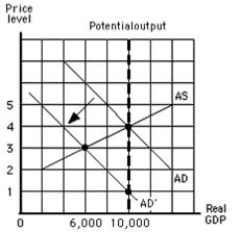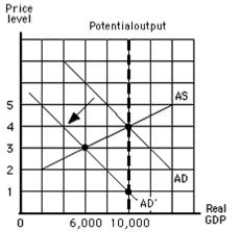A) the different costs associated with production.
B) the price and output decisions made by different industries.
C) the overall performance of the economy.
D) the role of a market in determining an efficient outcome.
E) the role of input suppliers in determining the price and quantity of output.
Correct Answer

verified
Correct Answer
verified
True/False
The failure of the mercantilism policy and the tax policy during the Great Depression proves that economic policies are meaningless and they do more harm than good.
Correct Answer

verified
Correct Answer
verified
Multiple Choice
Economists use the price index to eliminate year-to-year changes in GDP due solely to changes in:
A) the exchange rate.
B) the unemployment rate.
C) fiscal spending.
D) consumer demand.
E) the price level.
Correct Answer

verified
Correct Answer
verified
Multiple Choice
The Keynesian approach to economic policy is also known as:
A) supply-side economics.
B) Classical economics.
C) demand-side economics.
D) mercantilism.
E) laissez-faire.
Correct Answer

verified
Correct Answer
verified
Multiple Choice
The figure below shows the aggregate demand and supply curves for the U.S.The figure given below shows that the price level changes from _____ when the aggregate supply curve shifts from AS' to AS''.
Figure 5.3

A) 4 to 2
B) 2 to 3
C) 2 to 2
D) 3 to 1
E) 2 to 4
Correct Answer

verified
Correct Answer
verified
Multiple Choice
Which of the following factors can partly explain the long-term growth in production in the U.S.economy?
A) Trade surpluses and accumulation of precious metals
B) A gradual but consistent increase in the price level
C) Growth in population
D) Improvements in technology
E) Federal government budget deficits
Correct Answer

verified
Correct Answer
verified
True/False
The aggregate supply curve reflects the inverse relationship between the interest rate and the quantity of real GDP supplied.
Correct Answer

verified
Correct Answer
verified
Multiple Choice
Economic fluctuations:
A) are linked,but not perfectly synchronized,across countries.
B) are perfectly synchronized across countries.
C) in one country are independent of fluctuations in other countries.
D) in the United States always occur after fluctuations in other developed economies.
E) in the United States usually occur before fluctuations in other developed economies.
Correct Answer

verified
Correct Answer
verified
Multiple Choice
The market value of all final goods and services produced in a nation during a particular period is called the:
A) gross domestic product.
B) net national product.
C) national income.
D) gross national product.
E) gross world product.
Correct Answer

verified
Correct Answer
verified
Multiple Choice
The figure below shows the aggregate demand and supply curves for the U.S.In this figure,which of the following might cause a shift in the aggregate demand curve from AD to AD'?
Figure 5.3

A) An increase in household wealth
B) A fall in domestic interest rates
C) An increase in government spending
D) An appreciation of the dollar relative to other currencies
E) A decrease in the nation's money supply
Correct Answer

verified
Correct Answer
verified
Multiple Choice
According to John Maynard Keynes' General Theory of Employment,Interest and Money,the government should _____ in order to get an economy out of a depression.
A) increase spending
B) decrease spending
C) reduce subsidies
D) increase taxes
E) allow the economy to correct itself
Correct Answer

verified
Correct Answer
verified
Showing 141 - 151 of 151
Related Exams